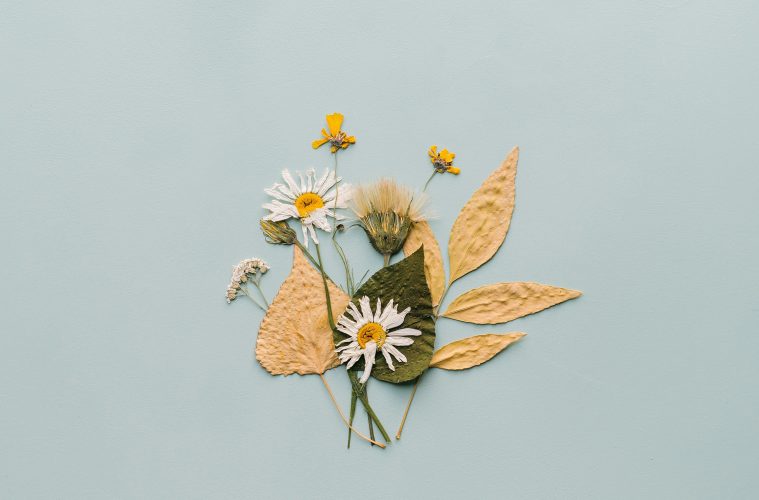Wondering what you can do to prolong the life of the beautiful blooms you received on Valentine’s Day? Or perhaps, there’s a wildflower that never fails to capture your attention when you’re strolling through the park, or in the garden?
Enter the crafty practice of flower pressing – a simple method of preserving blooms for artwork, diarising, or sentimental value.
Flower pressing is a relatively straightforward method of preserving flowers by flattening them and removing their moisture.
Finding your flowers
If you’ll be pressing flowers from a bouquet, keep the bouquet in water until it’s time to press. However, if you’re venturing outdoors to find flowers to press, there are a few important pointers one should keep in mind.
Be mindful of endangered species in South Africa
It is very important to know which flower species in your environment are endangered before plucking any florals.
South Africa has a red list of endangered plant species. Some flowers include Silkypuff varieties (Diastella buekii, Diastella myrtifolia, Diastella parilis), the Comb Bobbejaantjie (Babiana secunda) and the Cocktail Winecup (Geissorhiza eurystigma).
Keep yourself in the know by familiarising yourself with this list to avoid picking any flowers that are endangered. Many of these blooms are beautiful, it’s easy to make the mistake of plucking them when you don’t know they’re at risk of becoming instinct.
Only take what you need
When you’re picking flowers, only take what you need, and leave behind enough flowers for pollination and reproduction. Some flowers may also serve as important food sources for surrounding wildlife.
Avoid picking flowers from areas where they’re essential for the survival of pollinators or other animals, and avoid over-harvesting to ensure the sustainability of wildflower populations.
Be sure you’re in the clear
Some regions in South Africa may have seasonal restrictions on flower picking to protect vulnerable species during their blooming periods. Check local regulations and guidelines before picking flowers. Also, be mindful of conservation areas and ensure you’ve got permission for flower picking and are following regulations in areas such as parks and botanical gardens.
The process of pressing
Now it’s time for the fun part – pressing your flowers. When it comes to flower pressing, delicate flowers work better as compared to chunkier flowers which may contain more water. After all, pressing is a process of drying, so daintier flowers will work better, and won’t take as long. Flowers with flat petals, such as daisies or pansies, work well.
STEP 1: Once you’ve selected a flower with minimal blemishes, trim excess stems and leaves, leaving only the blossoms or desired parts of the plant that you would like to press and preserve.
STEP 2: Then, cut sheets of absorbent material, such as blotting paper, parchment paper, coffee filters or newspaper, into squares slightly larger than your flowers.
STEP 3: Lay one sheet of the absorbent material on a flat surface. Arrange one or more flowers face down on the paper, ensuring they’re not touching or overlapping. Then, place another sheet of absorbent material on top of them. Repeat this process to create alternating layers of flowers and absorbent material.
STEP 4: Now’s the time to apply pressure. Place the layered flowers between the pages of a heavy book, ensuring that the book is large enough to accommodate the flowers without crushing them. You can also use a flower press designed specifically for this purpose. Alternatively, you may use a hammer to lightly press out moisture in your flowers – be careful though, as you don’t want to damage their delicate bits.
STEP 5: Leave the flowers pressed for about 1-3 weeks to allow them to fully dry and flatten, and check on them periodically to ensure they’re drying properly. Some flowers may take longer, depending on their size and water content.
STEP 6: After the pressing period, carefully open the book or flower press and check the flowers for dryness. They should feel dry and papery to the touch. If they are, gently remove the pressed flowers from the absorbent material. Be careful as they may be very delicate. We recommend using tweezers and a very steady, gentle hand.
Once you’ve got your pressed flowers
Once your flowers are pressed, you can store them in a cool, dry place or use them for various crafts.
Some ideas include cards, pressed flower candles, framed pressed flowers, or pressed flowers in resin, which make for gorgeous trinkets for jewellery, or for hanging art, such as a mobile.
ALSO SEE:
Article originally written and published by Savanah Douglas for Woman&Home.
Feature image: Pexels

